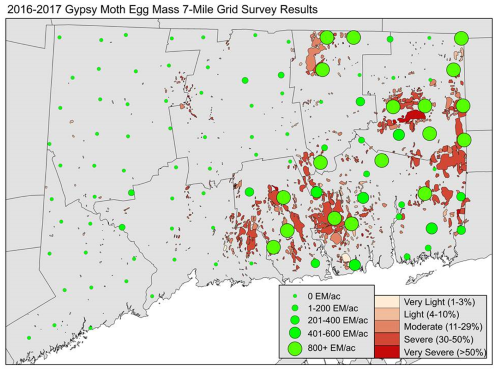Press Releases

03/23/2017
CAES and DEEP Anticipate Another Spring of Heavy Gypsy Moth Defoliation
May and June Rains to Determine Effectiveness of Beneficial Fungus
Connecticut’s Agricultural Experiment Station (CAES) and Department of Energy and Environmental Protection (DEEP) cautioned residents today to anticipate a heavy presence of gypsy moth caterpillars this spring along with significant defoliation of hardwood trees. Gypsy moth populations have been on the rise since 2014 with the greatest impacts so far in southeastern and south central Connecticut.
“All indications lead us to believe we will see yet another year of severe gypsy moth damage to trees and forests in the upcoming months,” said Deputy Commissioner Susan Whalen.
“Dry spring weather in recent years has limited the effectiveness of a naturally occurring soil borne fungus, Entomophaga maimaiga, which is lethal to only gypsy moth caterpillars and normally keeps their populations in check.”
“Dry spring weather in recent years has limited the effectiveness of a naturally occurring soil borne fungus, Entomophaga maimaiga, which is lethal to only gypsy moth caterpillars and normally keeps their populations in check.”
“Our state-wide gypsy moth egg mass survey, especially in eastern Connecticut, shows large amounts of gypsy moth egg masses, which leads us to believe there will be a continued hatch and extensive caterpillar activity in 2017,” said Kirby Stafford, CAES State Entomologist. “Residents, arborists, and foresters have also reported large amounts of gypsy moth egg masses. We really need normal amounts of precipitation in May or early June to activate the fungus and knock back the gypsy moth population. It is also important to remember that Connecticut has experienced similar cyclical outbreaks, with the weather eventually favoring growth and effectiveness of the Entomophaga maimaiga fungus.”
Annual forest pest and disease aerial surveys conducted by CAES documented gypsy moth caterpillars defoliated 1,337 acres in 2014 and 175,273 acres in 2015. Two consecutive dry springs in 2015 and 2016, have allowed significant increase in gypsy moth populations resulting in 204,167 acres defoliated in 2016, mostly in south eastern and south central Connecticut. While the total acreage impacted by the gypsy moth was not dramatically higher in 2016, the degree of defoliation was more severe.
“While most trees will refoliate initially, repeated attacks from Gypsy moths can weaken a tree’s natural ability to ward off secondary stressors such as drought or other insects and disease. Oaks are most preferred tree species” said Chris Martin, DEEP Director of Forestry. “Under heavy infestation gypsy moths will eat just about everything with green leaves and even needles. Some people may remember that nearly 1.5 million acres were defoliated by the gypsy moth in 1981, and while we lost trees, our forests recovered.”
Gypsy moth infestations are difficult to control over wide areas and while there are no plans for state-funded spraying, individuals interested in pursuing treatments should hire a certified arborist or licensed pesticide applicator to protect their trees in a safe and effective manner.
“DEEP and CAES recognize homeowners are concerned with repeated summers devoid of leaf cover that provides beneficial cooling shade. Woodland owners are also concerned about widespread damage and even tree mortality from repeated gypsy moth defoliations,” added Martin.
Information highlighting the history, life cycle, and impacts on trees and forests of gypsy moths, along with recommended management strategies, can be found on the CAES web page that includes The Gypsy Moth fact sheet and on DEEP’s web page at www.ct.gov/deep/gypsymoths
For further information, please visit the The Connecticut Agricultural Experiment Station and DEEP: Forestry websites.
For further information, please visit the The Connecticut Agricultural Experiment Station and DEEP: Forestry websites.
Aerial survey map of Connecticut showing areas defoliated by the gypsy moth in 2016 overlaid with the results of the 2016-2017 CAES egg mass 7-mile grid ground survey. Survey and map produced by the Office of the State Entomologist, CAES. The aerial survey is funded by the U.S. Forest Service.

- Twitter: @CTDEEPNews
- Facebook: DEEP on Facebook

